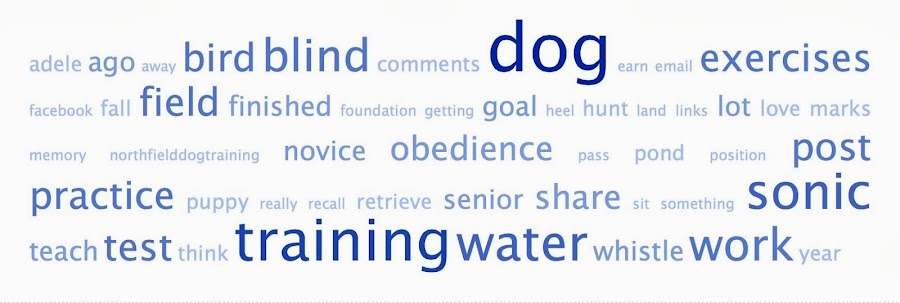In switching back to the obedience world after several months focused on field training and hunt tests, I've been attending some local fun matches, as well as helping several students prepare for the ring, some for their first time. It's gotten me thinking about The Big Picture. By that I mean what I am aiming for long term with a particular dog. When you are training your first dog, there is simply so much to learn. I can still remember the first time I saw a Utility class at an obedience trial (circa 1985), and thinking, very naively, "That doesn't look too hard." Wrong! Utility is hard. But Utility is also what I'm aiming at with my dog, and my early training reflects that long term goal. For example, I teach my puppies how to do the skills needed for the position change portion of the Signal Exercise - to me, the ultimate obedience teamwork exercise. I get them started on learning to retrieve and do go-outs. The former opens up all sorts of fun exercises to work on with your dog, and go-outs take a long time to solidify, so it helps to start them early.
My goal at each level is to start to show in a given class when I know the dog understands the exercises well enough to qualify in a respectable way. It doesn't always mean that we do qualify, just that there isn't any one exercise we are consistently failing. The dog has shown me through our training and our attendance at obedience fun matches that he can do so even in a distracting environment. Does my dog need to be error free before I enter? No. My dog is probably always going to make some sort of error in the ring - I've only had one 200 in my many years of showing. It is the seriousness of the error that I look at. If my dog is sitting crooked on some halts, that is a very different error than not sitting on most halts. The former is typically 1/2-1 point off, depending on just how crooked the dog sits. A no sit is pricey, and some judges will NQ you if your dog never or hardly ever sits on heeling.
When I'm preparing my dog for the ring, I want to first iron out errors that are likely to lead to an NQ or substantial deductions (3 or more points), such as no sits, auto finishes, short or not straight go-outs, really lousy pickups or mouthing on retrieves, slowness anywhere. I don't want walking from my dog anywhere except for the slow on heeling! I would much rather have a crooked front or finish, but have speed and attention from my dog. With a lot of dogs, if you nit pick them constantly about every front or finish, they usually slow down and lose attitude. I want attitude and "try" first, with precision coming with time and training.
One of the important skills I have learned over the years of competing with my dogs is that of not dwelling on mistakes already made. There were times when Gryffin failed the first exercise, and then would fail a couple more, I think because of my dwelling on the first mistake. I had to remember to let it go and concentrate on making the rest of the performance the best it could be.
Roughing in the exercises can go quickly for an experienced trainer. Like a fine wine that needs time to develop its full potential, it is the polishing and teamwork and dog's true understanding of the work that takes time. Take the time it takes to get there.
